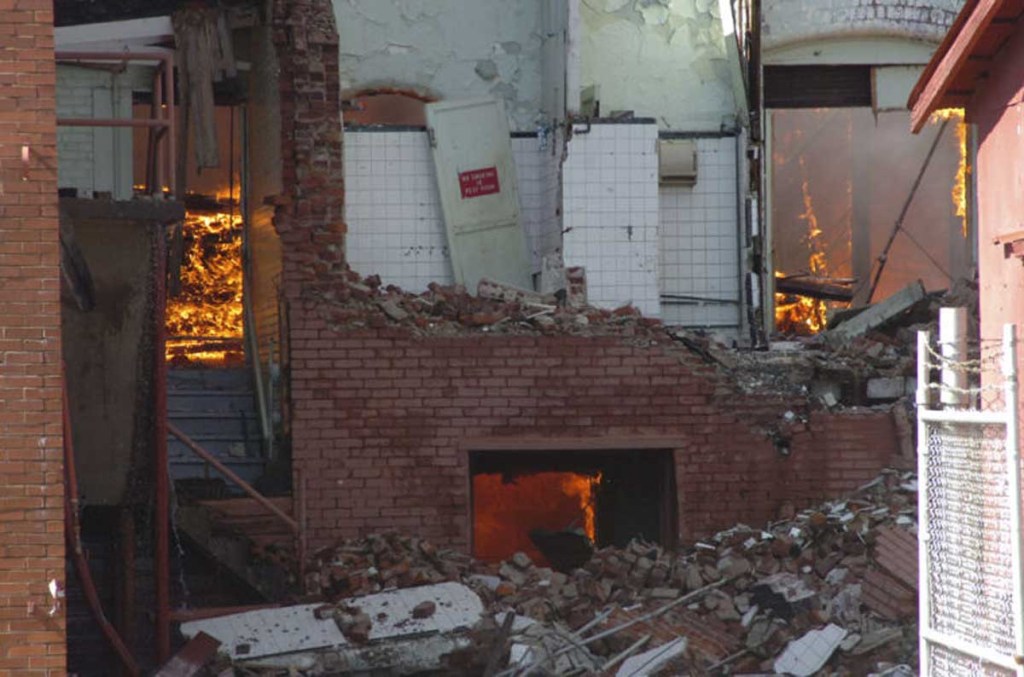History Burned: A Look Back
Published 2:43 pm Friday, February 13, 2009

- Flames roared for hours inside the historic factory interior.
[Editor’s note: in light of the historic loss of Avondale Mills last Valentine’s day, we would like to commemorate the sad occasion by re-publishing the story that highlihgted events from that day]
Debris rained down and onlookers shook their heads in disbelief as the historic Avondale Mills burned Thursday.
At around 9:30 a.m. the fire broke out and within minutes it spread to engulf the mill’s entire main structure. According to local officials on the scene, a worker fleeing the fire said that they were using acetylene torches to cut the steel beams in the building’s superstructure. The fire department has since confirmed this account.
Pell City Fire Chief Mike Sewell said that his department initially got the call at 9:50 a.m. Valentine’s Day. Sewell said that Pell City’s fire department entered the building and began to douse the flames and evaluate the situation.
“After the fire broke through the main barrier of the plant and flames were shooting 80 feet in the air, we switched from an offensive attack to a defensive mode and I called in aerial trucks from surrounding areas,” Sewell said. “We did an interior offensive attack on the main building where the seed of the fire was.”
Chief Sewell confirmed that workers were using acetylene torches to cut through I-beams in the ceiling and were initially unaware of the fire until someone noticed smoke emitting from the roof. He said that sparks caught old cotton dust in the ductwork on fire. He also noted that because the ductwork spanned the building, it allowed the fire to spread rapidly.
“At the time the work was being done, a spotter with a fire hose was part of the demolition team. When the spark occurred the spotter did successfully put out the immediate fire. What the workers did not realize is that the spark had ignited cotton fiber residue in ductwork running through the building. Once in the ductwork, the fire became out of control,” said Jeff Hooper, from Ackermann Public Relations representing Thunder Enterprises.
“Once [the fire] dropped the main ductwork in there, we got out. That’s when we switched to a defensive attack,” Sewell said. “Once it got its main oxygen supply and that got underneath the ceiling of tar and gravel, it spread real quick.”
Sewell said that the fire was free burning for 21 hours. Fire crews were also on hand all day Friday and the majority of crews were able to leave late Friday afternoon. “I had the engine companies come out every hour and douse main spots where fires would pop up.”
The chief also said that the Pell City Fire Department is greatly indebted to its neighboring departments for helping to put out the historic blaze.
“I appreciate the help of the surrounding communities who were able to come and help volunteer-wise. That was a large fire and it’s hard to contain with what we had here in Pell City. I want to thank them so much for everything they did and also I want to thank those who provided food to those at the scene,” Chief Sewell said.
“We have spent months carefully dismantling the mill to reclaim antique heart pine timbers and brick for use in new construction and we are sickened by the loss of these rare materials. The main mill building is a total loss, but thanks to the quick response from the Pell City and Moody Fire Departments and many others, an adjacent warehouse was saved,” said Matt Winn, Vice President of Development for Thunder Enterprises.
According to employees at Coast Gas, which is located across from the mill on Cogswell Avenue, for two days there had been sparks coming from a side window where workers were cutting I-beams. The window is located near where the blaze began.
Fire departments from as far away as Talladega were called and engines were sent to the scene to control the blaze. Firefighters from Riverside, Palmerdale, Ragland, Whitney Junction, Wolf Creek, Odenville, Moody, Talladega, Lincoln and Wattsville also helped. There were no reports of injury to demolition workers or firefighters.
After the fire roared for around 45 minutes, the roof collapsed on the building containing the fire. Minutes later, Moody’s engine was trying to control the opposite end of the blaze, as Pell City’s engine also streamed a continuous torrent of water.
By mid afternoon, a diesel fuel truck was brought in to refill the half dozen fire engines at the scene.
Other than the firefighters, many people helped in one way or another. Police officers worked to control traffic and onlookers. Businesses from all over Pell City donated food and drinks for all the onsite firefighters and workers. There was no shortage of generosity and help for everyone working the blaze.
Ellen Haynes, director of the St. Clair County EMA, said the EMA just tried to help out anyway they could. “Our role was a support role. Anything they needed or needs that might have arisen we helped fulfill those needs. We are the connection between the city, county and state.” The EMA also provided five 25 to 30 foot lights that helped to illuminate the operation Thursday and Friday night. Haynes said they got the lights from three different counties.
Questions about the environmental impact of the fire on the air and water quality have been raised and some answers have been given. “I don’t know that the air quality would be affected. The wind helped out to clear out some of the smoke,” Haynes said.
She also mentioned that the water might be a slightly bigger concern. “We’re monitoring the water run-off. There were a lot of different types of things in the building, wood varnish, whatever. You have to keep an eye on the water and where it’s going.”
The Alabama Department of Environmental Management (ADEM) has been taking samples of the area and the stream next to the mill. Scott Hughes, spokesman for (ADEM), said they have had workers on the site testing for potential threats. “We walked the stream down to river and identified limited fish kill in the direct area around the mill, but there doesn’t appear to be fish kill downstream.”
Hughes said the owners of the mill were responsible for hiring a consultant to test water runoff to check for chemicals. He also mentioned that they didn’t believe the actual mill released any harmful chemicals during the fire and the partial collapse and that everyone worked well together. “Everybody’s been cooperative, the city, responsible party and emergency personnel.”
“Pell City and St. Clair County have good leadership and will recover from the loss of this industry and building. I look forward to continuing to work with community leaders and the St. Clair County Economic Development Council as they promote projects to enhance the quality of life for citizens in St. Clair County,” said Congressman Spencer Bachus R-District 6, U.S. House of Representatives.
Amidst the nostalgia for the loss of a Pell City fixture for over one hundred years, there may be a hint of irony.
“I’ve been trying to make sense of all of this and it seems like she [the mill] said, Rather than move me, I’ll die right here,’” said Judge Bill Hereford.




